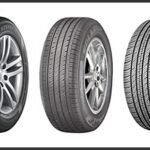To determine if you have all-season tires, check the sidewall for the letters “m+s” or “m&s” which indicate it is an all-season tire. Additionally, all-season tires usually have a more symmetrical tread pattern compared to winter or summer tires.
All-season tires are designed to provide adequate performance in various weather conditions, making them popular among drivers. However, not all tires marketed as all-season actually perform well in all weather conditions. It is important to check for the “m+s” or “m&s” designation on the tire’s sidewall to be sure you are getting true all-season tires.
In this article, we will discuss other ways to identify all-season tires so you can make an informed decision when purchasing tires for your vehicle.

Credit: www.youtube.com
Understanding The Characteristics Of All Season Tires
If you’re wondering if your vehicle has all-season tires, it’s crucial to understand their characteristics. Unlike summer and winter tires, all-season tires are designed to tackle year-round weather conditions. Here are some essential traits of all-season tires that you should know.
Tread Pattern And Design
One of the primary characteristics of all-season tires is their tread pattern, which is designed to provide adequate grip in both wet and dry conditions. Compared to winter tires, all-season tires often have a shallower and less aggressive tread pattern, providing a smoother drive on the road.
Despite this, they still have enough space between the tread blocks to channel away water and slush, reducing the risk of hydroplaning.
Tread Depth
Another characteristic of all-season tires is the tread depth. They typically have a tread depth of around 8mm to provide maximum traction on both wet and dry surfaces. However, keep in mind that the tread depth can wear off over time, decreasing the tire’s performance and its ability to maintain traction on the road.
Consequently, it’s essential to monitor the tread depth and replace the tires promptly when it reaches 2/32 inches or shallower.
Rubber Composition And Flexibility
All-season tires are made with a unique rubber composition designed to withstand a range of temperatures. They strike a balance between the harder rubber compound of summer tires and the softer compound of winter tires. The softer compound allows for more flexibility in colder temperatures, improving traction on snowy and icy roads, while the harder compound offers better grip in warmer conditions.
This compound mixture ensures that the tire can handle a variety of temperatures throughout the year.
All in all, understanding the critical characteristics of all-season tires is essential when it comes to maintaining your vehicle’s safety and performance. By monitoring the tread depth, inspecting the tire’s pattern and design, and checking the rubber composition, you’ll have a better understanding of your all-season tires and how they work.
How To Tell If Your Tires Are All Season Tires
How to tell if you have all season tires: a comprehensive guide
Tires are an essential part of your vehicle, and it’s crucial to know what type of tire you’re using. One of the most common types of tires is all-season tires, but how do you tell if you have them? In this blog post, we’ll give you a comprehensive guide on how to identify all-season tires.
Check The Tire Sidewall For Markings
All-season tires have a specific marking on their sidewall, indicating they are all-season tires. The marking usually says “m+s” (mud and snow) or “all-season. ” These markings can be found on the side of the tire facing outwards.
Conduct The Penny Test
Another way to check if you have all-season tires is the penny test. Take a penny and insert it into the tire’s grooves with lincoln’s head facing downwards. If you can see all of lincoln’s head, it’s time to replace your tires.
If lincoln’s hair is partially visible, your tread depth is still in good shape, and you have all-season tires.
Observe Performance On Different Road Conditions
Finally, the simplest way to know if you have all-season tires is to observe their performance on different road conditions. If your tires handle adequately in wet, dry, and light snowy conditions, there’s a good chance they are all-season tires.
However, if you encounter difficulties in these conditions, it might be time to switch to all-season tires.
Identifying all-season tires can be done with the right knowledge. Ensure you check your tire sidewalls for markings, conduct the penny test, and observe your tires’ performance on different road conditions. Knowing what type of tire you have will not only ensure your safety but also extend the life of your tires.
Maintenance And Care Of All Season Tires
All season tires are versatile and designed to provide reliable traction all year round, but they require proper maintenance and care to ensure optimum performance and longevity. In this section, we will discuss the essential aspects of maintaining your tires: rotation and balancing, alignment, inflation pressure.
Rotation And Balancing
Regular tire rotation and balancing are critical maintenance practices that ensure even wear and prolong tire life. Rotating your tires at regular intervals (every 5,000-8,000 miles) helps to distribute the wear pattern evenly across all four tires, thereby prolonging their life and improving fuel efficiency.
Balancing, on the other hand, helps to minimize vibrations and prevents uneven wearing on the tire treads.
- Rotate your tires every 5,000-8,000 miles or according to the manufacturer’s recommendations.
- Have your tires balanced when you install new tires or if you notice excessive vibration.
Alignment
Getting your tires aligned is essential for ensuring even tire wear, improving vehicle handling and stability, and maximizing fuel efficiency. Alignment involves adjusting the angles of the wheels so they point straight ahead and perpendicular to the ground. Misaligned wheels can cause uneven tire wear, steering difficulties, and increased fuel consumption.
- Get your tires aligned at least once a year or if you notice any symptoms of misalignment, such as uneven tire wear, pulling to one side, or a crooked steering wheel.
Inflation Pressure
Maintaining proper tire pressure is crucial for your safety and the tire’s performance. Tires that are overinflated or underinflated can cause reduced handling, increased stopping distances, poor fuel economy, and premature wear. Check your tire pressure regularly (at least once a month) and always keep it at the recommended level specified by the manufacturer.
- Check your tire pressure monthly or before you take a long trip.
- Inflate your tires to the recommended pressure indicated on the tire placard or owner’s manual.
- Avoid overinflating or underinflating your tires to ensure maximum safety and performance.
Maintaining your all-season tires is crucial for long-lasting performance, optimum fuel efficiency and maximum safety. Regular rotation and balancing, alignment, and proper inflation pressure are the key elements of tire maintenance. By following these tips, you can prolong the life of your tires, save money in the long run, and ensure a smooth and safe driving experience.
Frequently Asked Questions For How To Tell If You Have All Season Tires?
What Are All-Season Tires?
All-season tires are designed for use in both wet and dry conditions. They are made to provide good traction in a wide range of temperatures.
How Can I Tell If My Tires Are All-Season?
Check the sidewall of the tire for the letters “m+s” (mud and snow) or “all-season. Alternatively, check the tire’s owner’s manual.
What Are The Benefits Of All-Season Tires?
All-season tires provide good year-round traction, reducing the need to change tires with the seasons. They are a good choice for drivers in moderate climates.
Can I Use All-Season Tires In Winter?
While all-season tires are designed to provide good traction in a wide range of conditions, they are not the best choice for extreme winter conditions.
How Do All-Season Tires Compare To Winter Tires?
All-season tires provide adequate traction in cold, wet, and snowy conditions, but winter tires are designed specifically for superior traction in extreme winter weather.
Conclusion
After reading this guide, you should now be equipped with the knowledge to identify whether you have all season tires. It is crucial to ensure your tires are suitable for the season you’re driving in to ensure your safety on the road and the longevity of your tires.
All season tires can provide better handling in various weather conditions, but it is always recommended to check your manufacturer’s recommendations to ensure the best performance for your specific vehicle. Remember to check your tire’s tread depth and look out for any visible signs of damage or wear and tear.
If you’re still unsure about your tire’s suitability for your driving conditions, seek advice from a professional mechanic or your tire dealer. Regular maintenance and care for your tires are key to maintaining your vehicle’s safety and performance.

Tamim Hasan is an experienced content strategist and automotive enthusiast specializing in SEO driven car care guides and practical vehicle maintenance tutorials. His goal is to help everyday drivers understand their cars better and make smarter repair decisions.










